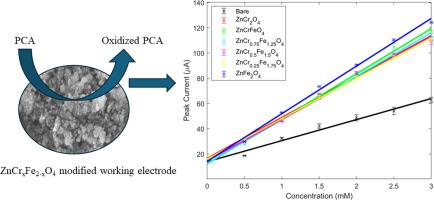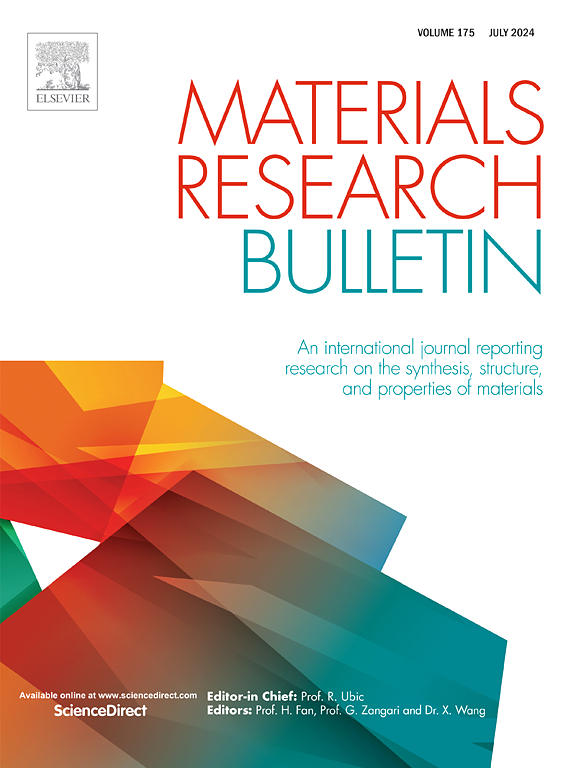Effect of Cr substitution in ZnFe2O4 nanoparticles on the electron transfer at electrochemical interfaces
IF 5.3
3区 材料科学
Q2 MATERIALS SCIENCE, MULTIDISCIPLINARY
引用次数: 0
Abstract
In this study, we explored the effect of Cr³⁺ substitution by partially and fully replacing Fe³⁺ in the normal spinel ZnFe₂O₄ crystal structure at electrochemical interfaces. The resulting ZnCrₓFe₂₋ₓO₄ nanomaterials exhibited an average particle size between 20 and 50 nm with a spherical morphology. The materials also demonstrated energy band gaps ranging from 2.1 to 3.1 eV X-ray diffraction (XRD) analysis confirmed that all the synthesized materials maintained a normal spinel structure, attributed to the octahedral site preference energy (OSPE) of Zn²⁺, Fe³⁺, and Cr³⁺ ions. Electrochemical performance assessments revealed that the ZnFe₂O₄-based sensor achieved a sensitivity of (37.8 ± 0.2) μA/mM with a kinetic rate constant of (13.1 ± 2.8) ms⁻¹, while the ZnCr₂O₄-based sensor exhibited a sensitivity of (32.4 ± 0.5) μA/mM and a kinetic rate constant of (3.73 ± 0.55) ms⁻¹ in the detection of paracetamol, whereas ZnCrFeO4 sensor has produced the second-best sensitivity (35.7 ± 0.1 μA/mM) and the rate constant (4.53 ± 0.54 ms⁻¹) with the lowest limit of detection (1.94 ± 0.01 μM). These differences in electrochemical performance were correlated with the variations in the energy band gaps caused by the restructuring of the normal spinel structure. Our findings indicate that the ZnFe₂O₄ sensor has a higher potential for direct electron transfer, whereas the other sensors are more likely to facilitate surface-mediated electron transfer.

ZnFe2O4 纳米粒子中的铬替代物对电化学界面电子转移的影响
在本研究中,我们通过在电化学界面上部分和全部取代正常尖晶石 ZnFe₂O₄ 晶体结构中的 Fe³⁺,探索了 Cr³⁺ 取代的效果。由此产生的 ZnCrₓFe₂₋ₓO₄纳米材料的平均粒径在 20 至 50 纳米之间,呈球形。这些材料还显示出 2.1 至 3.1 eV 的能带隙 X 射线衍射(XRD)分析证实,所有合成材料都保持了正常的尖晶石结构,这归因于 Zn²⁺、Fe³⁺ 和 Cr³⁺ 离子的八面体位点偏爱能(OSPE)。电化学性能评估显示,基于 ZnFe₂O₄ 的传感器的灵敏度为 (37.8 ± 0.2) μA/mM,动力学速率常数为 (13.1 ± 2.8) ms-¹,而基于 ZnCr₂O₄ 的传感器的灵敏度为 (32.4 ± 0.5) μA/mM,动力学速率常数为 (13.1 ± 2.8) ms-¹。5) μA/mM,动力学速率常数为 (3.73 ± 0.55) ms-¹,而 ZnCrFeO4 传感器的灵敏度(35.7 ± 0.1 μA/mM)和速率常数(4.53 ± 0.54 ms-¹)次之,检出限最低(1.94 ± 0.01 μM)。电化学性能的这些差异与正常尖晶石结构重组导致的能带隙变化有关。我们的研究结果表明,ZnFe₂O₄ 传感器具有更高的直接电子转移潜力,而其他传感器则更有可能促进表面介导的电子转移。
本文章由计算机程序翻译,如有差异,请以英文原文为准。
求助全文
约1分钟内获得全文
求助全文
来源期刊

Materials Research Bulletin
工程技术-材料科学:综合
CiteScore
9.80
自引率
5.60%
发文量
372
审稿时长
42 days
期刊介绍:
Materials Research Bulletin is an international journal reporting high-impact research on processing-structure-property relationships in functional materials and nanomaterials with interesting electronic, magnetic, optical, thermal, mechanical or catalytic properties. Papers purely on thermodynamics or theoretical calculations (e.g., density functional theory) do not fall within the scope of the journal unless they also demonstrate a clear link to physical properties. Topics covered include functional materials (e.g., dielectrics, pyroelectrics, piezoelectrics, ferroelectrics, relaxors, thermoelectrics, etc.); electrochemistry and solid-state ionics (e.g., photovoltaics, batteries, sensors, and fuel cells); nanomaterials, graphene, and nanocomposites; luminescence and photocatalysis; crystal-structure and defect-structure analysis; novel electronics; non-crystalline solids; flexible electronics; protein-material interactions; and polymeric ion-exchange membranes.
 求助内容:
求助内容: 应助结果提醒方式:
应助结果提醒方式:


